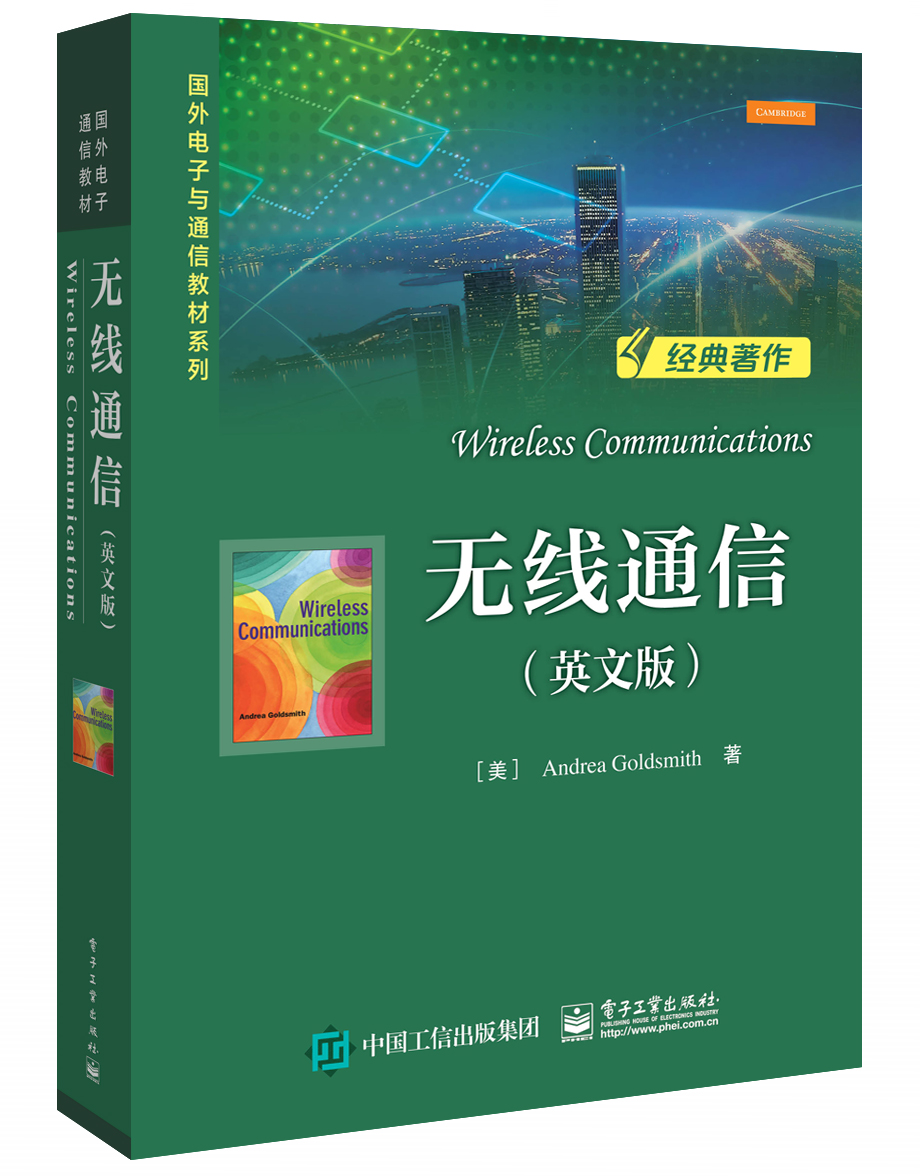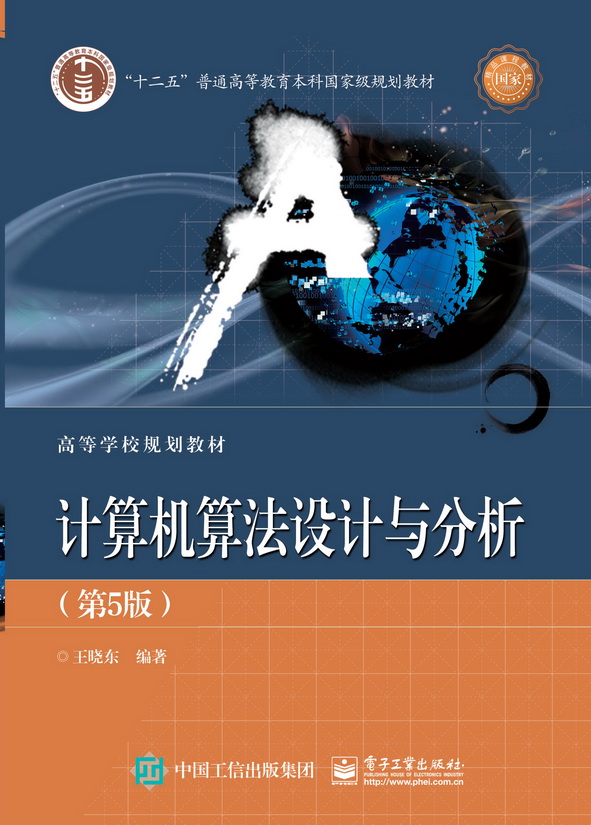无线通信(英文版)
丛 书 名:
国外电子与通信教材系列
作 译 者:Andrea Goldsmith(安德莉亚 · 戈德史密斯)
出 版 日 期:2020-04-01
书 代 号:G0387120
I S B N:9787121387128
图书简介:
本书可向授课教师提供英文原版教辅(习题解答等),具体申请方式请联系Te_service@phei.com.cn。本书是无线通信领域的一本优秀的经典教材,介绍了无线通信的基本原理,重点论述了无线通信系统的基本理论与设计分析方法。全书内容包括无线信道模型、无线信道容量、无线通信中的调制编码技术及均衡处理技术、分集、扩频通信,还包括多天线系统、多用户系统、多载波调制、自适应调制与编码、蜂窝系统及无线自组织网络等。影印版制作时已根据配套网站提供的勘误表(2006年版)对内容进行了更正。
-
配 套 资 源
-
图 书 内 容
内容简介
本书可向授课教师提供英文原版教辅(习题解答等),具体申请方式请联系Te_service@phei.com.cn。本书是无线通信领域的一本优秀的经典教材,介绍了无线通信的基本原理,重点论述了无线通信系统的基本理论与设计分析方法。全书内容包括无线信道模型、无线信道容量、无线通信中的调制编码技术及均衡处理技术、分集、扩频通信,还包括多天线系统、多用户系统、多载波调制、自适应调制与编码、蜂窝系统及无线自组织网络等。影印版制作时已根据配套网站提供的勘误表(2006年版)对内容进行了更正。图书详情
ISBN:9787121387128开 本:16开页 数:668字 数:1389.0本书目录
1 Overview of Wireless Communications 无线通信概述 1.1 History of Wireless Communications 无线通信的历史 1.2 Wireless Vision 无线愿景 1.3 Technical Issues 技术问题 1.4 Current Wireless Systems 现有无线系统 1.4.1 Cellular Telephone Systems 蜂窝电话系统 1.4.2 Cordless Phones 无绳电话系统 1.4.3 Wireless Local Area Networks 无线局域网 1.4.4 Wide Area Wireless Data Services 广域无线数据业务 1.4.5 Broadband Wireless Access 宽带无线接入 1.4.6 Paging Systems 寻呼系统 1.4.7 Satellite Networks 卫星通信网 1.4.8 Low-Cost, Low-Power Radios: Bluetooth and ZigBee 低成本、低功率的无线通信:蓝牙和紫蜂 1.4.9 Ultrawideband Radios 超宽带无线通信 1.5 The Wireless Spectrum 无线频谱 1.5.1 Methods for Spectrum Allocation 频谱的分配方式 1.5.2 Spectrum Allocations for Existing Systems 现有系统的频谱分配 1.6 Standards 标准 Problems 习题 References 参考文献 2 Path Loss and Shadowing 路径损耗和阴影衰落 2.1 Radio Wave Propagation 无线电波传播 2.2 Transmit and Receive Signal Models 发送和接收信号模型 2.3 Free-Space Path Loss 自由空间路径损耗 2.4 Ray Tracing 射线跟踪 2.4.1 Two-Ray Model 两径模型 2.4.2 Ten-Ray Model (Dielectric Canyon) 十径模型(介电峡谷) 2.4.3 General Ray Tracing 通用射线跟踪 2.4.4 Local Mean Received Power 本地平均接收功率 2.5 Empirical Path-Loss Models 经验路径损耗模型 2.5.1 Okumura Model 奥村模型 2.5.2 Hata Model 哈塔模型 2.5.3 COST 231 Extension to Hata Model 哈塔模型的COST 231扩展 2.5.4 Piecewise Linear (Multislope) Model 折线(多斜率)模型 2.5.5 Indoor Attenuation Factors 室内衰减因子 2.6 Simplified Path-Loss Model 简化的路径损耗模型 2.7 Shadow Fading 阴影衰落 2.8 Combined Path Loss and Shadowing 路径损耗和阴影衰落的混合模型 2.9 Outage Probability under Path Loss and Shadowing 路径损耗和阴影衰落造成的中断率 2.10?Cell Coverage Area 小区覆盖范围 Problems 习题 References 参考文献 3 Statistical Multipath Channel Models 统计多径信道模型 3.1 Time-Varying Channel Impulse Response 时变信道的冲激响应 3.2 Narrowband Fading Models 窄带衰落模型 3.2.1 Autocorrelation, Cross-Correlation, and Power Spectral Density 自相关、互相关和功率谱密度 3.2.2 Envelope and Power Distributions 包络和功率分布 3.2.3 Level Crossing Rate and Average Fade Duration 电平通过率和平均衰落时长 3.2.4 Finite-State Markov Channels 有限状态马尔可夫信道 3.3 Wideband Fading Models 宽带衰落模型 3.3.1 Power Delay Profile 功率时延谱 3.3.2 Coherence Bandwidth 相干带宽 3.3.3 Doppler Power Spectrum and Channel Coherence Time 多普勒功率谱和信道相干时间 3.3.4 Transforms for Autocorrelation and Scattering Functions 自相关和散射函数的变换 3.4 Discrete-Time Model 离散时间模型 3.5 Space-Time Channel Models 空时信道模型 Problems 习题 References 参考文献 4 Capacity of Wireless Channels 无线信道的信道容量 4.1 Capacity in AWGN AWGN信道容量 4.2 Capacity of Flat Fading Channels 平坦衰落信道的容量 4.2.1 Channel and System Model 信道和系统模型 4.2.2 Channel Distribution Information Known 信道分布信息已知 4.2.3 Channel Side Information at Receiver 接收端已知CSI 4.2.4 Channel Side Information at Transmitter and Receiver 收发两端都已知CSI 4.2.5 Capacity with Receiver Diversity 接收分集的信道容量 4.2.6 Capacity Comparisons 容量对比 4.3 Capacity of Frequency-Selective Fading Channels 频率选择性衰落信道的容量 4.3.1 Time-Invariant Channels 时不变信道 4.3.2 Time-Varying Channels 时变信道 Problems 习题 References 参考文献 5 Digital Modulation and Detection 数字调制与检测 5.1 Signal Space Analysis 信号空间分析 5.1.1 Signal and System Model 信号与系统模型 5.1.2 Geometric Representation of Signals 信号的几何表示 5.1.3 Receiver Structure and Sufficient Statistics 接收机结构和充分统计量 5.1.4 Decision Regions and the Maximum Likelihood Decision Criterion 判决域和最大似然判决准则 5.1.5 Error Probability and the Union Bound 误码率和联合界 5.2 Passband Modulation Principles 带通调制原理 5.3 Amplitude and Phase Modulation 幅度/相位调制 5.3.1 Pulse Amplitude Modulation (MPAM) 脉冲幅度调制 5.3.2 Phase-Shift Keying (MPSK) 相移键控 5.3.3 Quadrature Amplitude Modulation (MQAM) 正交幅度调制 5.3.4 Differential Modulation 差分调制 5.3.5 Constellation Shaping 星座成形 5.3.6 Quadrature Offset 正交偏移 5.4 Frequency Modulation 频率调制 5.4.1 Frequency-Shift Keying (FSK) and Minimum-Shift Keying (MSK) 频移键控和最小频移键控 5.4.2 Continuous-Phase FSK (CPFSK) 连续相位频移键控 5.4.3 Noncoherent Detection of FSK FSK的非相干检测 5.5 Pulse Shaping 脉冲成形 5.6 Symbol Synchronization and Carrier Phase Recovery 码元同步和载波相位恢复 5.6.1 Receiver Structure with Phase and Timing Recovery 具有相位和定时恢复的接收机结构 5.6.2 Maximum Likelihood Phase Estimation 最大似然相位估计 5.6.3 Maximum Likelihood Timing Estimation 最大似然定时估计 Problems 习题 References 参考文献 6 Performance of Digital Modulation over Wireless Channels 无线信道中数字调制的性能 6.1 AWGN Channels AWGN信道 6.1.1 Signal-to-Noise Power Ratio and Bit /Symbol Energy 信噪比和比特/符号能量 6.1.2 Error Probability for BPSK and QPSK BPSK和QPSK的差错概率 6.1.3 Error Probability for MPSK MPSK的差错概率 6.1.4 Error Probability for MPAM and MQAM MPAM和MQAM的差错概率 6.1.5 Error Probability for FSK and CPFSK FSK和CPFSK的差错概率 6.1.6 Error Probability Approximation for Coherent Modulations 相干调制的差错概率的近似 6.1.7 Error Probability for Differential Modulation 差分调制的差错概率 6.2 Alternate Q-Function Representation Q函数的一种等效表示法 6.3 Fading 衰落信道 6.3.1 Outage Probability 中断率 6.3.2 Average Probability of Error 平均差错概率 6.3.3 Moment Generating Function Approach to Average Error Probability 用矩母函数求平均差错概率 6.3.4 Combined Outage and Average Error Probability 中断率和平均差错概率的结合 6.4 Doppler Spread 多普勒频移 6.5 Intersymbol Interference 码间干扰 Problems 习题 References 参考文献 7 Diversity 分集 7.1 Realization of Independent Fading Paths 独立衰落路径的实现 7.2 Receiver Diversity 接收分集 7.2.1 System Model 系统模型 7.2.2 Selection Combining 选择合并 7.2.3 Threshold Combining 阈值合并 7.2.4 Maximal-Ratio Combining 最大比合并 7.2.5 Equal-Gain Combining 等增益合并 7.3 Transmitter Diversity 发送分集 7.3.1 Channel Known at Transmitter 发送端已知信道 7.3.2 Channel Unknown at Transmitter – The Alamouti Scheme 发送端未知信道(Alamouti方案) 7.4 Moment Generating Functions in Diversity Analysis 利用矩母函数分析分集 7.4.1 Diversity Analysis for MRC MRC分集的分析 7.4.2 Diversity Analysis for EGC and SC EGC和SC分集的分析 7.4.3 Diversity Analysis for Noncoherent and Differentially Coherent Modulation 非相干和差分相干调制时分集系统的性能分析 Problems 习题 References 参考文献 8 Coding for Wireless Channels 无线信道中的编码 8.1 Overview of Code Design 码设计概述 8.2 Linear Block Codes 线性分组码 8.2.1 Binary Linear Block Codes 二进制线性分组码 8.2.2 Generator Matrix 生成矩阵 8.2.3 Parity-Check Matrix and Syndrome Testing 校验矩阵与伴随式 8.2.4 Cyclic Codes 循环码 8.2.5 Hard Decision Decoding (HDD) 硬判决译码 8.2.6 Probability of Error for HDD in AWGN AWGN信道中硬判决译码的差错概率 8.2.7 Probability of Error for SDD in AWGN AWGN信道中软判决译码的差错概率 8.2.8 Common Linear Block Codes 常见的线性分组码 8.2.9 Nonbinary Block Codes: The Reed Solomon Code 多进制分组码:Reed Solomon码 8.3 Convolutional Codes 卷积码 8.3.1 Code Characterization: Trellis Diagrams 编码特性:网格图 8.3.2 Maximum Likelihood Decoding 最大似然译码 8.3.3 The Viterbi Algorithm 维特比算法 8.3.4 Distance Properties 距离特性 8.3.5 State Diagrams and Transfer Functions?状态图和转移函数 8.3.6 Error Probability for Convolutional Codes 卷积码的误码率 8.4 Concatenated Codes 级联码 8.5 Turbo Codes Turbo码 8.6 Low-Density Parity-Check Codes 低密度校验码 8.7 Coded Modulation 编码调制 8.8 Coding with Interleaving for Fading Channels 衰落信道下的交织编码 8.8.1 Block Coding with Interleaving 分组码的交织 8.8.2 Convolutional Coding with Interleaving 卷积码的交织 8.8.3 Coded Modulation with Symbol/ Bit Interleaving 符号/比特交织的编码调制 8.9 Unequal Error Protection Codes 不等差错保护码 8.10?Joint Source and Channel Coding 信源信道联合编码 Problems 习题 References 参考文献 9 Adaptive Modulation and Coding 自适应调制与编码 9.1 Adaptive Transmission System 自适应传输系统 9.2 Adaptive Techniques 自适应技术 9.2.1 Variable-Rate Techniques 速率控制技术 9.2.2 Variable-Power Techniques 功率控制技术 9.2.3 Variable Error Probability 误码率控制技术 9.2.4 Variable-Coding Techniques 编码控制技术 9.2.5 Hybrid Techniques 混合技术 9.3 Variable-Rate Variable-Power MQAM 速率可变、功率可变的MQAM 9.3.1 Error Probability Bounds 误码率界 9.3.2 Adaptive Rate and Power Schemes 自适应速率及功率模式 9.3.3 Channel Inversion with Fixed Rate 固定速率的信道反转 9.3.4 Discrete-Rate Adaptation 离散速率的自适应 9.3.5 Average Fade Region Duration 衰落区的平均持续时间 9.3.6 Exact versus Approximate Bit Error Probability 误比特率的精确值和近似值的对比 9.3.7 Channel Estimation Error and Delay 信道估计误差和估计时延的影响 9.3.8 Adaptive Coded Modulation 自适应编码调制 9.4 General M-ary Modulations 一般的M进制调制 9.4.1 Continuous-Rate Adaptation 连续速率的自适应 9.4.2 Discrete-Rate Adaptation 离散速率的自适应 9.4.3 Average BER Target 平均BER目标 9.5 Adaptive Techniques in Combined Fast and Slow Fading 结合快衰落和慢衰落的自适应技术 Problems 习题 References 参考文献 10 Multiple Antennas and Space-Time Communications 多天线和空时通信 10.1 Narrowband MIMO Model 窄带MIMO模型 10.2 Parallel Decomposition of the MIMO Channel MIMO信道的并行分解 10.3 MIMO Channel Capacity MIMO信道的容量 10.3.1 Static Channels 静态信道 10.3.2 Fading Channels 衰落信道 10.4 MIMO Diversity Gain: Beamforming MIMO分集增益:波束成形 10.5 Diversity-Multiplexing Trade-offs 分集和复用的折中 10.6 Space-Time Modulation and Coding 空时调制与编码 10.6.1 ML Detection and Pairwise Error Probability 最大似然检测和成对差错概率 10.6.2 Rank and Determinant Criteria 秩和行列式准则 10.6.3 Space-Time Trellis and Block Codes 空时格码和空时分组码 10.6.4 Spatial Multiplexing and BLAST Architectures 空分复用和BLAST结构 10.7 Frequency-Selective MIMO Channels 频率选择性MIMO信道 10.8 Smart Antennas 智能天线 Problems 习题 References 参考文献 11 Equalization 均衡 11.1 Equalizer Noise Enhancement 均衡器中的噪声增强 11.2 Equalizer Types 均衡器的类型 11.3 Folded Spectrum and ISI-Free Transmission 折叠谱和无ISI传输 11.4 Linear Equalizers 线性均衡 11.4.1 Zero-Forcing (ZF) Equalizers 迫零均衡 11.4.2 Minimum Mean-Square Error (MMSE) Equalizers 最小均方误差均衡 11.5 Maximum Likelihood Sequence Estimation 最大似然序列估计 11.6 Decision-Feedback Equalization 判决反馈均衡 11.7 Other Equalization Methods 其他均衡方法 11.8 Adaptive Equalizers: Training and Tracking 自适应均衡:训练和跟踪 Problems 习题 References 参考文献 12 Multicarrier Modulation 载波调制 12.1 Data Transmission Using Multiple Carriers 多载波数据传输 12.2 Multicarrier Modulation with Overlapping Subchannels 重叠子信道的多载波调制 12.3 Mitigation of Subcarrier Fading 子载波衰落的抑制 12.3.1 Coding with Interleaving over Time and Frequency 时频域交织编码 12.3.2 Frequency Equalization 频域均衡 12.3.3 Precoding 预编码 12.3.4 Adaptive Loading 自适应加载 12.4 Discrete Implementation of Multicarrier Modulation 离散多载波调制的实现 12.4.1 The DFT and Its Properties DFT及其性质 12.4.2 The Cyclic Prefix 循环前缀 12.4.3 Orthogonal Frequency-Division Multiplexing (OFDM) 正交频分复用 12.4.4 Matrix Representation of OFDM OFDM的矩阵表示 12.4.5 Vector Coding 向量编码 12.5 Challenges in Multicarrier Systems 多载波系统中的挑战 12.5.1 Peak-to-Average Power Ratio 峰均比 12.5.2 Frequency and Timing Offset 频率偏移和时间偏移 12.6 Case Study: The IEEE 802.11a Wireless LAN Standard 案例研究:IEEE 802.11a无线局域网标准 Problems 习题 References 参考文献 13 Spread Spectrum 扩频 13.1 Spread-Spectrum Principles 扩频原理 13.2 Direct-Sequence Spread Spectrum (DSSS) 直接序列扩频 13.2.1 DSSS System Model DSSS系统模型 13.2.2 Spreading Codes for ISI Rejection: Random, Pseudorandom, and m-Sequences 抑制ISI的扩频码:随机码、伪随机码和m序列 13.2.3 Synchronization 同步 13.2.4 RAKE Receivers RAKE接收机 13.3 Frequency-Hopping Spread Spectrum (FHSS) 跳频扩频系统 13.4 Multiuser DSSS Systems 多用户DSSS系统 13.4.1 Spreading Codes for Multiuser DSSS 多用户DSSS系统中的扩频码 13.4.2 Downlink Channels 下行信道 13.4.3 Uplink Channels 上行信道 13.4.4 Multiuser Detection 多用户检测 13.4.5 Multicarrier CDMA 多载波CDMA 13.5 Multiuser FHSS Systems 多用户FHSS系统 Problems 习题 References 参考文献 14 Multiuser Systems 多用户系统 14.1 Multiuser Channels: The Uplink and Downlink 多用户信道:上行与下行 14.2 Multiple Access 多址接入 14.2.1 Frequency-Division Multiple Access (FDMA) 频分多址接入 14.2.2 Time-Division Multiple Access (TDMA) 时分多址接入 14.2.3 Code-Division Multiple Access (CDMA) 码分多址接入 14.2.4 Space-Division Multiple Access (SDMA) 空分多址接入 14.2.5 Hybrid Techniques 混合多址接入 14.3 Random Access 随机接入 14.3.1 Pure ALOHA 纯ALOHA 14.3.2 Slotted ALOHA 时隙ALOHA 14.3.3 Carrier-Sense Multiple Access (CSMA) 载波监听多址接入 14.3.4 Scheduling 调度 14.4 Power Control 功率控制 14.5 Downlink (Broadcast) Channel Capacity 下行(广播)信道容量 14.5.1 Channel Model 信道模型 14.5.2 Capacity in AWGN AWGN信道容量 14.5.3 Common Data 公共数据 14.5.4 Capacity in Fading 衰落信道容量 14.5.5 Capacity with Multiple Antennas 多天线容量 14.6 Uplink (Multiple Access) Channel Capacity 上行(多址)信道容量 14.6.1 Capacity in AWGN AWGN信道容量 14.6.2 Capacity in Fading 衰落信道容量 14.6.3 Capacity with Multiple Antennas 多天线容量 14.7 Uplink–Downlink Duality 上下行信道的对偶性 14.8 Multiuser Diversity 多用户分集 14.9 MIMO Multiuser Systems MIMO多用户系统 Problems 习题 References 参考文献 15 Cellular Systems and Infrastructure-Based Wireless Networks 蜂窝系统和架构式无线网络 15.1 Cellular System Fundamentals 蜂窝系统的基本概念 15.2 Channel Reuse 信道复用 15.3 SIR and User Capacity SIR和用户容量 15.3.1 Orthogonal Systems (TDMA/FDMA) 正交系统(TDMA/FDMA) 15.3.2 Nonorthogonal Systems (CDMA) 非正交系统 (CDMA) 15.4 Interference Reduction Techniques 抗干扰技术 15.5 Dynamic Resource Allocation 动态资源分配 15.5.1 Scheduling 调度 15.5.2 Dynamic Channel Assignment 动态信道分配 15.5.3 Power Control 功率控制 15.6 Fundamental Rate Limits 基本速率极限 15.6.1 Shannon Capacity of Cellular Systems 蜂窝系统的香农容量 15.6.2 Area Spectral Efficiency 面积频谱效率 Problems 习题 References 参考文献 16 Ad Hoc Wireless Networks 无线自组织网络 16.1 Applications 应用 16.1.1 Data Networks 数据网络 16.1.2 Home Networks 家庭网络 16.1.3 Device Networks 设备网络 16.1.4 Sensor Networks 传感器网络 16.1.5 Distributed Control Systems 分布式控制系统 16.2 Design Principles and Challenges 设计原则和挑战 16.3 Protocol Layers 协议层 16.3.1 Physical Layer Design 物理层设计 16.3.2 Access Layer Design 接入层设计 16.3.3 Network Layer Design 网络层设计 16.3.4 Transport Layer Design 传输层设计 16.3.5 Application Layer Design 应用层设计 16.4 Cross-Layer Design 跨层设计 16.5 Network Capacity Limits 网络的容量极限 16.6 Energy-Constrained Networks 能量受限网络 16.6.1 Modulation and Coding 调制和编码 16.6.2 MIMO and Cooperative MIMO MIMO及合作MIMO 16.6.3 Access, Routing, and Sleeping 接入、路由和休眠 16.6.4 Cross-Layer Design under Energy Constraints 能量约束下的跨层设计 16.6.5 Capacity per Unit Energy 单位能量的容量 Problems 习题 References 参考文献 Appendix A Representation of Bandpass Signals and Channels 带通信号和信道的表示 Appendix B Probability Theory, Random Variables, and Random Processes 概率论、随机变量和随机过程 Appendix C Matrix Definitions, Operations, and Properties 矩阵的定义、运算和性质 Appendix D Summary of Wireless Standards 无线标准摘要 Bibliography 参考书目 Index 索引展开前 言
Preface Wireless communications is a broad and dynamic field that has spurred tremendous excitement and technological advances over the last fewdecades. The goal of this book is to provide readers with a comprehensive understanding of the fundamental principles underlying wireless communications. These principles include the characteristics and performance limits of wireless systems, the techniques and mathematical tools needed to analyze them, and the insights and trade-offs associated with their design. Current and envisioned wireless systems are used to motivate and exemplify these fundamental principles. The book can be used as a senior- or graduate-level textbook and as a reference for engineers, academic and industrial researchers, and students working in the wireless field. ORGANIZATION OF THE BOOK Chapter 1 begins with an overview of wireless communications, including its history, a vision for the future, and an overview of current systems and standards. Wireless channel characteristics, which drive many of the challenges in wireless system design, are described in Chapters 2 and 3. In particular, Chapter 2 covers path loss and shadowing in wireless channels, which vary over relatively large distances. Chapter 3 characterizes the flat and frequency-selective properties of multipath fading, which change over much smaller distances – on the order of the signal wavelength. Fundamental capacity limits of wireless channels along with the capacity-achieving transmission strategies are treated in Chapter 4. Although these techniques have unconstrained complexity and delay, they provide insight and motivation for many of the practical schemes discussed in later chapters. In Chapters 5 and 6 the focus shifts to digital modulation techniques and their performance in wireless channels. These chapters indicate that fading can significantly degrade performance. Thus, fading mitigation techniques are required for high-performance wireless systems. The next several chapters cover the primary mitigation techniques for flat and frequencyselective fading. Specifically, Chapter 7 covers the underlying principles of diversity techniques, including a newmathematical tool that greatly simplifies performance analysis. These techniques can remove most of the detrimental effects of flat fading. Chapter 8 provides comprehensive coverage of coding techniques, including mature methods for block, convolutional, and trellis coding as well as recent developments in concatenated, turbo, and LDPC codes. This chapter illustrates that, though coding techniques for noisy channels have near-optimal performance, many open issues remain in the design and performance analysis of codes for wireless systems. Chapter 9 treats adaptive modulation in flat fading, which enables robust and spectrally efficient communication by leveraging the time-varying nature of the wireless channel. This chapter also ties the techniques and performance of adaptive modulation to the fundamental capacity limits of flat fading channels. Multiple-antenna techniques and space-time communication systems are covered in Chapter 10: the additional spatial dimension enables high data rates and robustness to fading. Equalization, which exploits signal processing in the receiver to compensate for frequency-selective fading, is covered in Chapter 11. Multicarrier modulation, described in Chapter 12, is simpler and more flexible than equalization for frequency-selective fading mitigation. Single-user and multiuser spread-spectrum techniques are described in Chapter 13. These techniques not only mitigate frequency-selective fading, they also allow multiple users to share the same wireless spectrum. The last three chapters of the book focus on multiuser systems and networks. Chapter 14 treats multiple and random access techniques for sharing the wireless channel among many users with continuous or bursty data. Power control is also covered in this chapter as a mechanism to reduce interference between users while ensuring that all users meet their performance targets. The chapter closes by discussing the fundamental capacity limits of multiuser channels as well as the transmission and channel sharing techniques that achieve these limits. Chapter 15 covers the design, optimization, and performance analysis of cellular systems, along with advanced topics related to power control and fundamental limits in these systems. The last chapter, Chapter 16, discusses the fundamental principles and open research challenges associated with wireless ad hoc networks. REQUIRED BACKGROUND The only prerequisite knowledge for the book is a basic understanding of probability, random processes, and Fourier techniques for system and signal analysis. Background in digital communications is helpful but not required, as the underlying principles from this field are covered in the text. Three appendices summarize key background material used in different chapters of the text. Specifically, Appendix A discusses the equivalent lowpass representation of bandpass signals and systems, which simplifies bandpass system analysis. Appendix B provides a summary of the main concepts in probability and random processes that are used throughout the book. Appendix C provides definitions, results, and properties related to matrices, which are widely used in Chapters 10 and 12. The last appendix, Appendix D, summarizes the main characteristics of current wireless systems and standards. BOOK FEATURES The tremendous research activity in the wireless field – coupled with the complexity of wireless system design – make it impossible to provide comprehensive details on all topics discussed in the book. Thus, each chapter contains a broad list of references that build and expand on what is covered in the text. The book also contains nearly a hundred worked examples to illustrate and highlight key principles and trade-offs. In addition, the book includes about 300 homework exercises. These exercises, which fall into several broad categories, are designed to enhance and reinforce the material in the main text. Some exercises are targeted to exemplify or provide more depth to key concepts, as well as to derive or illustrate properties of wireless systems using these concepts. Exercises are also used to prove results stated but not derived in the text. Another category of exercises obtains numerical results that give insight into operating parameters and performance of wireless systems in typical environments. Exercises also introduce new concepts or system designs that are not discussed in the text. A solutions manual is available that covers all the exercises. USING THIS BOOK IN COURSES The book is designed to provide much flexibility as a textbook, depending on the desired length of the course, student background, and course focus. The core of the book is in Chapters 1 through 6. Thereafter, each chapter covers a different stand-alone topic that can be omitted or may be covered in other courses. Necessary prerequisites for a course using this text are an undergraduate course in signals and systems (both analog and digital) and one in probability theory and random processes. It is also helpful if students have a prerequisite or corequisite course in digital communications, in which case the material in Chapter 5 (along with overlapping material in other chapters) can be covered quickly as a review. The book breaks down naturally into three segments: core material in Chapters 1–6, single-user wireless system design in Chapters 7–13, and multiuser wireless networks in Chapters 14–16. Most of the material in the book can be covered in two to three quarters or two semesters. A three-quarter sequence would follow the natural segmentation of the chapters, perhaps with an in-depth research project at the end. For a course sequence of two semesters or quarters, the first course could focus on Chapters 1–10 (single-user systems with flat fading) and the second course could focus on Chapters 11–16 (frequency-selective fading techniques, multiuser systems, and wireless networks). A one-quarter or semester course could focus on single-user wireless systems based on the core material in Chapters 1–6 and selected topics from Chapters 7–13. In this case a second optional quarter or semester could be offered covering multiuser systems and wireless networks (part of Chapter 13 and Chapters 14–16). I use this breakdown in a two-quarter sequence at Stanford, where the second quarter is offered every other year and includes additional reading material from the literature as well as an in-depth research project. Alternatively, a one-quarter or semester course could cover both single and multiuser systems based on Chapters 1–6 and Chapters 13–16, with some additional topics from Chapters 7–12 as time permits. A companion Web site (http: //www.cambridge.org/9780521837163) provides supplemental material for the book, including lecture slides, additional exercises, and errata. ACKNOWLEDGMENTS It takes a village to complete a book, and I am deeply indebted to many people for their help during the multiple phases of this project. I first want to thank the ten generations of students at Caltech and Stanford who suffered through the annual revisions of my wireless course notes: their suggestions, insights, and experiences were extremely valuable in honing the topics, coverage, and tone of the book. John Proakis and several anonymous reviewers provided valuable and in-depth comments and suggestions on early book drafts, identifying omissions and weaknesses, which greatly strengthened the final manuscript. My current graduate students Rajiv Agrawal, Shuguang Cui,Yifan Liang, Xiangheng Liu, Chris Ng, and Taesang Yoo meticulously proofread many chapter drafts, providing new perspectives and insights, rederiving formulas, checking for typos, and catching my errors and omissions. My former graduate students Tim Holliday, Syed Jafar, Nihar Jindal, Neelesh Mehta, Stavros Toumpis, and Sriram Vishwanath carefully scrutinized one or more chapters and provided valuable input. In addition, all of my current and former students (those already mentioned as well as Mohamed-Slim Alouini, Soon-Ghee Chua, Lifang Li, and KevinYu) contributed to the content of the book through their research results, especially in Chapters 4, 7, 9, 10, 14, and 16. The solutions manual was developed by Rajiv Agrawal, Grace Gao, and Ankit Kumar. I am also indebted to many colleagues who took time from their busy schedules, sometimes on very short notice, to read and critique specific chapters. They were extremely gracious, generous, and honest with their comments and criticisms. Their deep and valuable insights not only greatly improved the book but also taught me a lot about wireless. For these efforts I am extremely grateful to Jeff Andrews, Tony Ephremides, Mike Fitz, Dennis Goeckel, Larry Greenstein, Ralf Koetter, P. R. Kumar, Muriel Médard, Larry Milstein, Sergio Servetto, Sergio Verdú, and Roy Yates. Don Cox was always available to share his infinite engineering wisdom and to enlighten me about many of the subtleties and assumptions associated with wireless systems. I am also grateful to my many collaborators over the years, as well as to my co-workers at Maxim Technologies and AT&T Bell Laboratories, who have enriched my knowledge of wireless communications and related fields. I am indebted to the colleagues, students, and leadership at Stanford who created the dynamic, stimulating, and exciting research and teaching environment in which this book evolved. I am also grateful for funding support from ONR and NSF throughout the development of the book. Much gratitude is also due to my administrative assistants Joice DeBolt and Pat Oshiro for taking care of all matters big and small in support of my research and teaching, and for making sure I had enough food and caffeine to get through each day. I would also like to thank copy editor Matt Darnell for his skill and attention to detail throughout the production process. My editor Phil Meyler has followed this book from its inception ten years ago until today. His encouragement and enthusiasm about the book never waned, and he has accommodated all of my changes and delays with grace and good humor. I cannot imagine a better editor with whom to embark on such a difficult, taxing, and rewarding undertaking. I would like to thank two people in particular for their early and ongoing support in this project and all my professional endeavors. Larry Greenstein ignited my initial interest in wireless through his deep insight and research experience. He has served as a great source of knowledge, mentoring, and friendship. Pravin Varaiya was deeply influential as a Ph.D. advisor and role model due to his breadth and depth of knowledge along with his amazing rigor, insight, and passion for excellence. He has been a constant source of encouragement, inspiration, and friendship. My friends and family have provided much love, support, and encouragement for which I am deeply grateful. I thank them for not abandoning me despite my long absences during the final stages of finishing the manuscript, and also for providing an incredible support network without which the book could not have been completed. I am especially grateful to Remy, Penny, and Lili for their love and support, and to my mother Adrienne for her love and for instilling in me her creativity and penchant for writing. My fatherWerner has profoundly influenced this book and my entire career both directly and indirectly. He was the senior Professor Goldsmith, a prolific researcher, author, and pioneer in many areas of mechanical and biological engineering. His suggestion to pursue engineering launched my career, for which he was my biggest cheerleader. His pride, love, and encouragement have been a constant source of support. I was fortunate to help him complete his final paper, and I have tried in this book to mimic his rigor, attention to detail, and obsession with typos that I experienced during that collaboration. Finally, no words are sufficient to express my gratitude and love for my husband Arturo and my children Daniel and Nicole. Arturo has provided infinite support for this book and every other aspect of my career, for which he has made many sacrifices. His pride, love, encouragement, and devotion have sustained me through the ups and downs of academic and family life. He is the best husband, father, and friend I could have dreamed of, and he enriches my life in every way. Daniel and Nicole are the sunshine in my universe – each day is brighter because of their love and sweetness. I am incredibly lucky to share my life with these three special people. This book is dedicated to them.展开作者简介
本书暂无作者简介 -
样 章 试 读
-
图 书 评 价 我要评论









